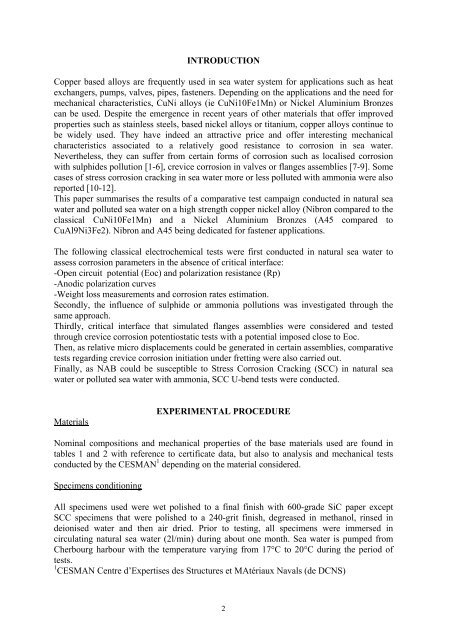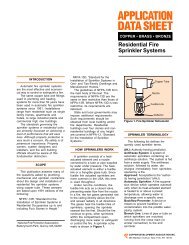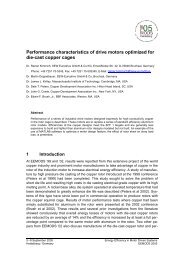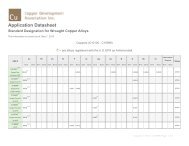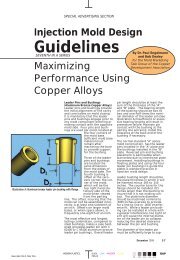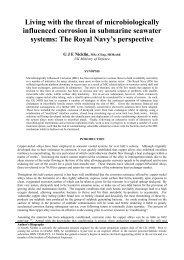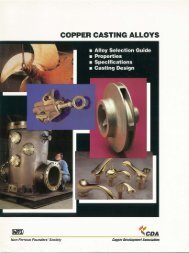Corrosion behaviour of copper alloys in natural sea water and ...
Corrosion behaviour of copper alloys in natural sea water and ...
Corrosion behaviour of copper alloys in natural sea water and ...
- No tags were found...
Create successful ePaper yourself
Turn your PDF publications into a flip-book with our unique Google optimized e-Paper software.
INTRODUCTIONCopper based <strong>alloys</strong> are frequently used <strong>in</strong> <strong>sea</strong> <strong>water</strong> system for applications such as heatexchangers, pumps, valves, pipes, fasteners. Depend<strong>in</strong>g on the applications <strong>and</strong> the need formechanical characteristics, CuNi <strong>alloys</strong> (ie CuNi10Fe1Mn) or Nickel Alum<strong>in</strong>ium Bronzescan be used. Despite the emergence <strong>in</strong> recent years <strong>of</strong> other materials that <strong>of</strong>fer improvedproperties such as sta<strong>in</strong>less steels, based nickel <strong>alloys</strong> or titanium, <strong>copper</strong> <strong>alloys</strong> cont<strong>in</strong>ue tobe widely used. They have <strong>in</strong>deed an attractive price <strong>and</strong> <strong>of</strong>fer <strong>in</strong>terest<strong>in</strong>g mechanicalcharacteristics associated to a relatively good resistance to corrosion <strong>in</strong> <strong>sea</strong> <strong>water</strong>.Nevertheless, they can suffer from certa<strong>in</strong> forms <strong>of</strong> corrosion such as localised corrosionwith sulphides pollution [1-6], crevice corrosion <strong>in</strong> valves or flanges assemblies [7-9]. Somecases <strong>of</strong> stress corrosion crack<strong>in</strong>g <strong>in</strong> <strong>sea</strong> <strong>water</strong> more or less polluted with ammonia were alsoreported [10-12].This paper summarises the results <strong>of</strong> a comparative test campaign conducted <strong>in</strong> <strong>natural</strong> <strong>sea</strong><strong>water</strong> <strong>and</strong> polluted <strong>sea</strong> <strong>water</strong> on a high strength <strong>copper</strong> nickel alloy (Nibron compared to theclassical CuNi10Fe1Mn) <strong>and</strong> a Nickel Alum<strong>in</strong>ium Bronzes (A45 compared toCuAl9Ni3Fe2). Nibron <strong>and</strong> A45 be<strong>in</strong>g dedicated for fastener applications.The follow<strong>in</strong>g classical electrochemical tests were first conducted <strong>in</strong> <strong>natural</strong> <strong>sea</strong> <strong>water</strong> toassess corrosion parameters <strong>in</strong> the absence <strong>of</strong> critical <strong>in</strong>terface:-Open circuit potential (Eoc) <strong>and</strong> polarization resistance (Rp)-Anodic polarization curves-Weight loss measurements <strong>and</strong> corrosion rates estimation.Secondly, the <strong>in</strong>fluence <strong>of</strong> sulphide or ammonia pollutions was <strong>in</strong>vestigated through thesame approach.Thirdly, critical <strong>in</strong>terface that simulated flanges assemblies were considered <strong>and</strong> testedthrough crevice corrosion potentiostatic tests with a potential imposed close to Eoc.Then, as relative micro displacements could be generated <strong>in</strong> certa<strong>in</strong> assemblies, comparativetests regard<strong>in</strong>g crevice corrosion <strong>in</strong>itiation under frett<strong>in</strong>g were also carried out.F<strong>in</strong>ally, as NAB could be susceptible to Stress <strong>Corrosion</strong> Crack<strong>in</strong>g (SCC) <strong>in</strong> <strong>natural</strong> <strong>sea</strong><strong>water</strong> or polluted <strong>sea</strong> <strong>water</strong> with ammonia, SCC U-bend tests were conducted.MaterialsEXPERIMENTAL PROCEDURENom<strong>in</strong>al compositions <strong>and</strong> mechanical properties <strong>of</strong> the base materials used are found <strong>in</strong>tables 1 <strong>and</strong> 2 with reference to certificate data, but also to analysis <strong>and</strong> mechanical testsconducted by the CESMAN 1 depend<strong>in</strong>g on the material considered.Specimens condition<strong>in</strong>gAll specimens used were wet polished to a f<strong>in</strong>al f<strong>in</strong>ish with 600-grade SiC paper exceptSCC specimens that were polished to a 240-grit f<strong>in</strong>ish, degreased <strong>in</strong> methanol, r<strong>in</strong>sed <strong>in</strong>deionised <strong>water</strong> <strong>and</strong> then air dried. Prior to test<strong>in</strong>g, all specimens were immersed <strong>in</strong>circulat<strong>in</strong>g <strong>natural</strong> <strong>sea</strong> <strong>water</strong> (2l/m<strong>in</strong>) dur<strong>in</strong>g about one month. Sea <strong>water</strong> is pumped fromCherbourg harbour with the temperature vary<strong>in</strong>g from 17°C to 20°C dur<strong>in</strong>g the period <strong>of</strong>tests.1 CESMAN Centre d’Expertises des Structures et MAtériaux Navals (de DCNS)2


